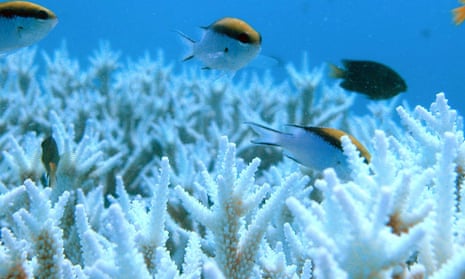Julie Bishop has intensified diplomatic efforts to avoid the Great Barrier Reef being deemed “in danger”, claiming any listing would set a “very dangerous precedent” that would affect other heritage sites around the world.
Bishop, who arrived in Lima for climate change talks on Tuesday, will use the trip to escalate Australia’s lobbying of other nations to avert the Great Barrier Reef being downgraded by Unesco’s world heritage committee next year.
The committee, comprised of experts from 20 countries, will decide whether the reef, which has lost half its coral cover in the past 30 years, should be listed as “in danger”.
Bishop said there is “no justification” for this to happen, warning it would have negative international ramifications.
“It would send a message around the world that even if you meet all of the criteria set out by the world heritage committee, there is still a risk that they will place an area on the in-danger list,” she told the Courier Mail.
“It would have significant implications for Australia but it would also set a very dangerous precedent for countries who don’t have the opportunity to take the action that Australia has.”
Referencing the sustained campaign by green groups to highlight the declining state of the reef, Bishop added: “Every country that has an environmental icon that activists seize upon would be at risk.”
At a meeting of the world heritage committee earlier this year, delegates “noted with concern” a plan to dump five million tonnes of dredged material within the reef’s world heritage area. That plan has now been reversed, with a new proposal to place the sediment on nearby wetlands.
Unesco has also questioned port expansions beside the reef, as well as water quality. The Australian government has said it is properly managing both of these issues.
The reef faces many other pressures, however, with a recent Great Barrier Reef Marine Park Authority (GBRMPA) report warning: “The overall outlook for the Great Barrier Reef is poor, has worsened since 2009 and is expected to further deteriorate in the future.
“Greater reductions of all threats at all levels, reef-wide, regional and local, are required to prevent the projected declines in the Great Barrier Reef and to improve its capacity to recover.”
The GBRMPA, the government’s reef agency, said climate change was the leading threat to the coral ecosystem, with pollution and a plague of coral-eating starfish also contributing to its deterioration.
The government has put together a long-term plan, called Reef 2050, to protect the reef, although the Australian Academy of Science has criticised it for being inadequate to prevent further decline.
Jon Day, who was director of heritage conservation at GBRMPA until July, said Bishop was mistaken in her analysis of the reef’s condition.
“What it comes down to is whether the reef’s values are being lost and the government’s own report shows that they are being lost,” Day, who was at GBRMPA for 28 years, told Guardian Australia. “In the government’s strategic report, over half of the reef’s 41 outstanding values are showing a deteriorating trend and that is what the committee will address.
“The GBRMPA’s report mentions climate change as the number one issue and yet the long-term plan mentions very little about climate change. The Australian government clearly sees an in-danger listing as embarrassing. We don’t just need business as usual here, we need to go beyond that in order to protect the reef.”
Day said a commitment from Greg Hunt, the environment minister, to ban the dumping of newly dredged spoil was a “furphy” because it relates to the reef’s marine park, not its larger world heritage area that includes port zones.
Terry Hughes, director of the ARC Centre of Excellence for Coral Reef Studies, said Bishop was guilty of “wishful thinking” over the reef’s condition.
“Her claims are contradicted by her own government’s reports, which couldn’t be more clear that the reef is deteriorating,” he told Guardian Australia.
“On one hand the commonwealth government is saying the reef is in poor condition and getting worse and on the other they are saying it’s the best-managed coral ecosystem in the world. Well, clearly it isn’t.”
The government’s lobbying efforts over the reef have gone on for several months, with Hunt and Andrew Powell, the Queensland environment minister, reportedly travelling to Europe to explain why the in-danger listing should be avoided.
Unesco chief Irina Bokova told Guardian Australia last month that Australia had started to address concerns over the reef’s health.
Dermot O’Gorman, chief executive of WWF, said: “We’re concerned that rather than redoubling efforts to save the Great Barrier Reef, the government is redoubling efforts to use diplomatic muscle to feed into the world heritage process.
“We have been communicating the message, from scientists, that the reef is under threat. Rather than blame green groups for talking it down, there should be a focus on how to turn it around.”

Comments (…)
Sign in or create your Guardian account to join the discussion